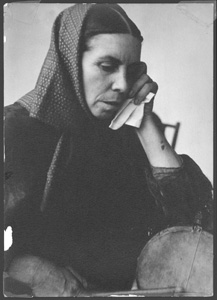|
Not a song genre, but part of the expressive vocal repertoire, is the uc, the long, drawn-out shrill cry of which parallels exist in most regions of Spain. In the Pityusans, the uc also served as a means of communication, and people knew and recognized the style of each extended family and often of each individual. It is also used as a verb, including in song texts: one, which appears to date from the fairly early 20th century, encourages the young men to try out their ucs: “Ucau, germans!” The song begins, “Cantarem sa cantarella”, que tots junts hem practicada”, “let’s sing the song, we’ve all practiced together” (Macabich 169; 202-3). It is not clear whether this refers to singing a song in unison, or to walking along the road to what was essentially a life contest only one of them could win – the festeig - , and practicing their individual uc’s, sequentially or even at the same time. The song text also refers to the girl being courted responding with a different type of uc, in a low voice, “molt fluixet, sa donzella… li respon…/amb un uc per petit sia” (“very quietly, the girl….answers him…with a very little uc”) . The song ends with a suggestion that, while upper social class people from the city disdain the uc, any of them who lived in the countryside for a year “ucaría més i més fort, ell tot sol, que tota la pagesia” (“would cry out ucs more and more loudly, by himself, than all the country people”)(Macabich 229). Today the uc is usually relegated to local dance occasions, where it is performed as a contest, with prizes. The contestants often use microphones, which is totally incongruous with the function of the uc as a loud communication sound heard from far away, |
8. Choirs, Music of the Church
|
While choirs, both secular and Church-related, flourish in th Pityusan Islands, they are outside the scope of these notes (for choirs, see Torres Planells, and for Church music, Torres i Peters). The flute and tabor, with castanets and struck sword, form part of the liturgy for certain Masses, especially Christmas. A very old chant genre survives in a rare field recording of a man in his nineties, who appears to be the only person in Ibiza who still sings parts of the long-disappeared Missa Pagesa. Entirely different from other Pityusan vocal genres, the winding melody and intricate vocal ornaments are more similar to, for example, Mallorcan agricultural work songs, a style often ascribed to Jewish or to “Moorish” influence (11). |
9. Instrumental music
Instruments found in Mallorca and Menorca, such as
stringed instruments, bagpipes, and the friction drum, ximbomba,
are not traditionally found in the Pityusans, although the American
writer Elliot Paul describes men playing accordion, violin, and other
instruments in the town of Santa Eulària in the 1930s. During the early
20th century various types of peninsular Spanish music were
adopted. Elliot Paul’s book, about life in Santa Eulària in the early
1930s, makes several references to men playing accordions, guitars, and
trumpets; decades earlier, Navarro observes that there are few guitars
to be found in Ibiza and fewer still guitarists – but, clearly, there
were some at the time, during the late nineteenth century (Navarro:45).
Until the mid-twentieth century, sailors accompanied their singing on
the guitar on August 15, the Assumption (Torres i Peters 2004, p.3.)
Although Flitch describes a blind ballad singer whose guitar was “always
hanging by his side” (182), he remarks that the Ibizans “never
naturalized the guitar” (188). The ballroom dances he observed (46) are
found today, in community centres today feature weekly dance evenings,
with an accordionist playing pasodobles and other popular dance
melodies. We were able to find only one man who still plays the
accordion in Ibiza, and he is elderly and suffering from health problems
which do not permit him to do very much with it. The main folk groups,
UC and Aires de Formentera, have experimented not only with new
instruments and styles, but as well, especially in the case of UC,
compose new melodies for words to older songs. Gypsy musicians in recent
years have begun to establish a presence; one such group refers to
themselves as “gitano pagès” (interview, Xupendi, February 2004).
Choirs and wind bands have played an important role in island musical
life since the mid-nineteenth century, as they have in most of mainland
Spain. In recent decades, hippie, discothèque and tourist cultures and
the more recent, annual “medieval fair”, have brought a wide variety of
instruments and musical styles to the islands.
|

